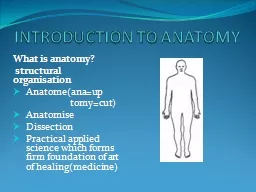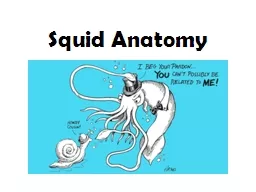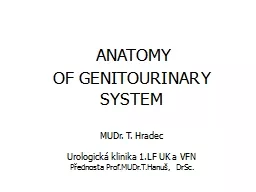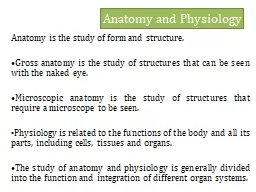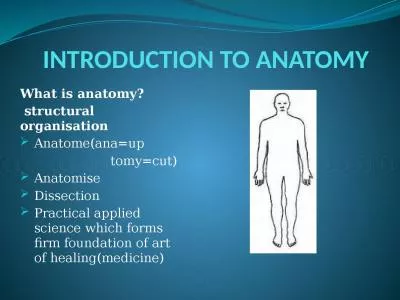PPT-Clinical Anatomy of Genitourinary system-I
Author : unisoftsm | Published Date : 2020-08-26
Lecture 16 Learning Objectives At the end of this session the student should be able to 1 Define cystoscopy and suprapubic aspiration 2 Describe bimanual pelvic
Presentation Embed Code
Download Presentation
Download Presentation The PPT/PDF document "Clinical Anatomy of Genitourinary system..." is the property of its rightful owner. Permission is granted to download and print the materials on this website for personal, non-commercial use only, and to display it on your personal computer provided you do not modify the materials and that you retain all copyright notices contained in the materials. By downloading content from our website, you accept the terms of this agreement.
Clinical Anatomy of Genitourinary system-I: Transcript
Lecture 16 Learning Objectives At the end of this session the student should be able to 1 Define cystoscopy and suprapubic aspiration 2 Describe bimanual pelvic examination of . Witmer PhD Lawrence M Witmer PhD Department of Biomedical Sciences College of Osteopathic Medicine Ohio University Athens Ohio 45701 witmerexchangeoucomohiouedu Handout download httpwwwoucomohiouedudbms witmergs rpachtm brPage 2br Feneis 1994 Feneis What is anatomy?. structural . organisation. Anatome. (. ana. =up. . tomy. =cut) . Anatomise. Dissection. Practical applied science which forms firm foundation of art of healing(medicine). Squid External Anatomy. Siphon. Fins. Mantle. Siphon: . Helps squid move by jet propulsion. Fins:. Help squid steer. Gills. Reproductive Organs. Siphon. Fins. Mantle. Squid Internal Anatomy. DIGESTIVE SYSTEM. A. Urinary System Infections. 1. Any condition that prevents or impairs the normal emptying of the bladder may increase the risk for infection. 2. Although the urinary system is most likely infected from organisms ascending the urethra, it can also be invaded by infections from the bloodstream. Thoracic Surgery. Prior to Surgery. Patient will need. SCD’s. Large bore IV/ Central line. A-Line. Bair Hugger. Positioning . Airplane. Headrest. Pillows. Vac Pac. Foley. Special Intubation needs. Anatomy of the Lungs. Dr. Tony Serino. “The nature of the body is the beginning of medical science.” . . Hippocrates ~350 . B.C.E. Intro: Topic Objectives. Be able to identify basic body plan that underlies all anatomy. Functions of the kidney. Excretory. Keeps the electrolyte balance. Keeps the acid-base balance. Keeps the water balance. Gross anatomy . Kidney. The right kidney is in a lower position than the left.. pharynx to esophagus all food changes that occur in the alimentary canalAnatomy Physiology Digestive System Ziser 2003breaking large molecules proteins fats starches etca thick coating of bicarbona ANA 202. 05/04/2020. Gross Anatomy of Pleura and Lungs. 2. The pleura is refer to as the serous membranes that lines the lungs and thoracic cavity.. Each pleural cavity is lined by a single layer of flat cells, mesothelium, and an associated layer of supporting connective tissue; together, they form the pleura. . SYSTEM. MUDr. T. Hradec . Urologická klinika 1.LF UK a VFN. Přednosta Prof.MUDr.T.Hanuš, DrSc.. Genitourinary system. Kidneys, adrenal glands. Upper urinary tract- calices, pelvis, ureter . Lower urinary tract- urinary bladder, urethra. •Gross anatomy is the study of structures that can be seen with the naked eye.. •Microscopic anatomy is the study of structures that require a microscope to be seen. . Physiology is related to the functions of the body and all its parts, including cells, tissues and organs.. GENITOURINARY SERVICE DIRECTOR: ASSOCIATE PROFESSOR DECLAN MURPHY TARGET AUDIENCE Referrers to the Genitourinary service PURPOSE To assist health professionals with the referral process. structural . organisation. Anatome. (. ana. =up. . tomy. =cut) . Anatomise. Dissection. Practical applied science which forms firm foundation of art of healing(medicine). F.I.C.O.G.. Objectives: by the end of this lecture, the 5. th. year student should be able to:. Define genitourinary fistula.. List its possible causes. Describe its different types. Demonstrate on the .
Download Document
Here is the link to download the presentation.
"Clinical Anatomy of Genitourinary system-I"The content belongs to its owner. You may download and print it for personal use, without modification, and keep all copyright notices. By downloading, you agree to these terms.
Related Documents


